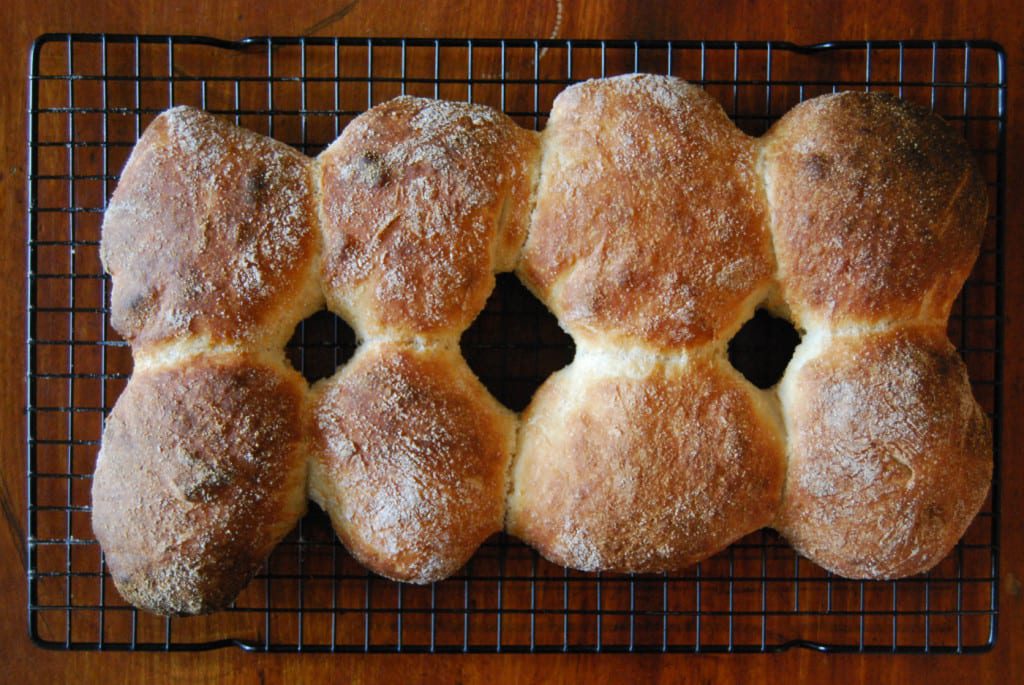In every newsagents, corner shop and petrol station across Glasgow (and elsewhere across Scotland) you will find freshly baked crispy morning rolls, probably piled up on top of a misused ice cream freezer.
McGhee’s bakery, one of the biggest producers of these rolls, sells over a staggering two million every week. So this is a bread produced on a massive industrial scale.
McGhee’s in fact produce this crispy roll specifically for the Glasgow market; elsewhere in Scotland their recipes for morning rolls differ.
Glasgow morning rolls are very light and airy, and very, very crispy on the outside. What helps to make them so crispy is the crumby coating they are given; this is actually rice cones, a rough textured rice flour.
The likes of Morton’s rolls are cut by hand producing odd shapes, which makes them all the more charming. They are often very well fired, and this is how some people prefer them.
Some of them are so black visitors to the city must wonder why they are on sale as it looks like someone has made a cock up.
They are also baked so they touch each other, forming a kissing crust.
When you tug the rolls apart there is a wee soft titbit inside that you can nibble on.
These morning rolls are central to life in Glasgow and other parts of Scotland. They are eaten at breakfast or made into sandwiches for a packed lunch.
Morning rolls must be eaten fresh as they go into rigour mortis by the end of the day.
They are essential for the ‘hot filled rolls’ served at almost every café and snack van, filled with the usual suspects of square sausage, or bacon, or black pudding, with a fried egg to make a doubler, and perhaps a potato scone.
It may not be the healthiest thing in the world, but it is a wonderful and well loved tradition.
Another favourite way for kids to eat them is for a snack after school, squished down and spread with butter so thick it leaves teethmarks.
After massively scaling down industrial quantities I have a recipe which is impressively similar to the rolls you get in Glasgow.
I have always wondered how they get them so light and airy and it turns out the answer is chemicals.
Morning rolls often contain something called IREKS Voltex, a multi-purpose bread improver that is used to iron out the millions of variable factors which can affect bread making.
If you produce two million rolls a week, you begin to understand why such a bakery would take measures to ensure they provide a consistent product.
On the other hand the rolls at some bakeries are batch fermented for up to 16 hours, meaning this bread has flavour; it is not a bread that is ready within an hour from start to finish like some other mass produced bread.
This recipe is for all the people who are from Glasgow but now live somewhere else, and might happen to miss this great Glasgow institution.

You need to start these the night before you want to eat them, however they last well and toast very well too.
Ingredients:
• 500g Canadian strong white bread flour (or a flour with a high gluten content, i.e. at least 14 per cent)
• 30g lard or vegetable shortening
• 10g sugar
• 10g salt
• 5g fast action yeast
• 400ml cold water
For the Coating
• 50g plain flour
• 50g rice cones/flour
Method:
1 Rub the fat into the flour in a large mixing bowl. Stir in the sugar, salt and yeast.
2 Now pour in the water and mix until it is all incorporated. This is a wet dough but when you are using bread flour with such a high gluten content it can easily take that much water without becoming sloppy.
3 Remove the dough from the bowl and knead it for 1 minute until the dough has just become smooth with all the ingredients thoroughly combined.
4 With such a long ferment you don’t need to knead it too much. Put the dough back into the bowl and cover loosely with cling film. Put the bowl in the refrigerator to leave it to ferment for 12 - 16 hours.
5 The next morning combine the rice cones and plain flour for the coating. Take a large baking sheet and dust it liberally with the coating mixture (make sure to leave enough to coat the rolls).
6 Empty the dough on to a work surface which has been liberally dusted with the rice/flour coating mixture. This is where a large silicone spatula or scraper is useful.
7 Now using a dough scraper divide the dough into 8 pieces. Don’t worry if it is sticky or messy as these rolls aren’t supposed to look perfect.
8 Dust your fingers with the coating mixture and take each piece of dough, one at a time, and dip it into the coating mixture and place it on the baking sheet. They don’t need to be in the shape of a roll but try to keep in the air that is inside the dough.
9 Do this with each piece, placing them near to each other so that when they rise they will bake together. Despite the stickiness of this dough the coating mixture works wonders for stopping the dough from sticking to everything. Leave them to rise for 1 - 2 hours or until doubled in size.
10 Bake in a 250˚C preheated oven on a high shelf for 15 - 20 minutes or until the tops are dark. The rolls should be well fired for the right flavour.
A history of the square sausage, including a recipe for making your own
A history of the Clootie Dumpling, including a recipe for making your own